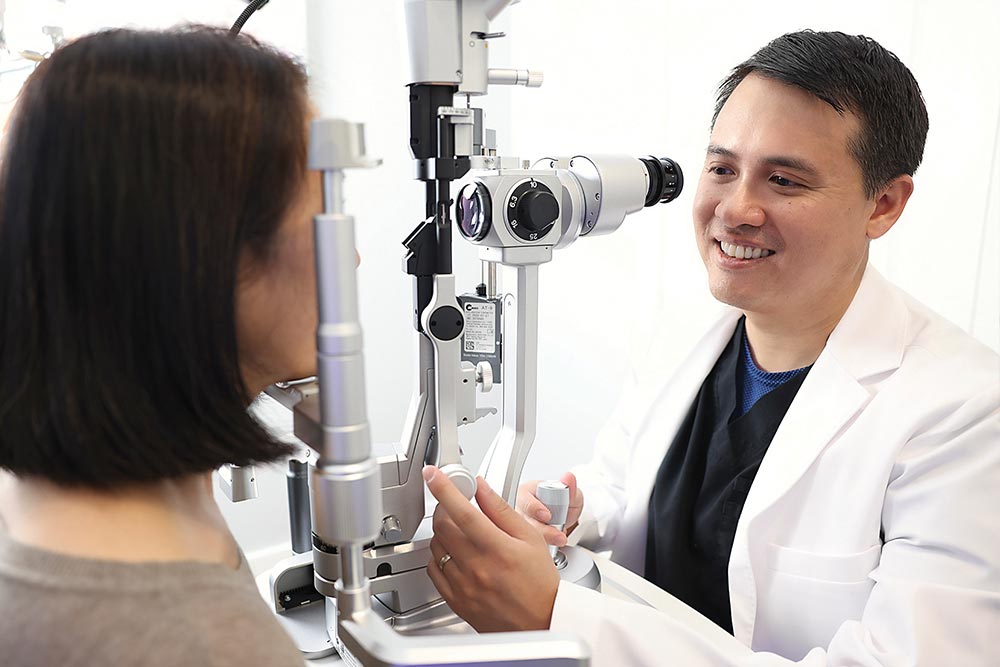Pterygium

Are you bothered by a growth on the surface of your eye? At Azure Eye Center, our fellowship trained ophthalmologist specializes in diagnosing, treating, and removing a pterygium and can help resolve your symptoms!
What is a Pterygium?
A pterygium is a fleshy growth that typically starts on the white inner corners of your eye and gradually grows inward. In some cases, a pterygium can grow so large that it begins to invade the cornea.
The cornea is the clear dome at the front of your eye. Once a pterygium reaches the cornea, it may become more bothersome for you, either from a cosmetic or symptomatic standpoint.
When advanced, a pterygium can even progress as far as the center of the cornea and affect the vision. Often, a pterygium does not require treatment.
However, your eye doctor may recommend the removal of the pterygium if it is causing unwanted symptoms, if you do not like the cosmetic appearance of the growth, or, especially, if the pterygium is interfering with your vision.
What Are the Symptoms of a Pterygium?
A pterygium is typically a painless growth that may only be noticeable when looking in the mirror or if another person points it out. It may appear slightly raised off of the surface of the eye and may contain blood vessels.
Although symptoms are typically mild, here are some of the most common symptoms of a pterygium:
- Eye discomfort or irritation
- Eye redness
- Blurry vision
- Feeling like there is something in the eye
In some instances, a pterygium may remain small. However, if the pterygium is advanced or continues to grow, it may cause blurry or distorted vision.
Who Is Most Likely to Develop a Pterygium?
A pterygium is also sometimes referred to as ‘surfers eye.’ Although the exact cause is unknown, many experts believe that pterygia often develop due to exposure to UV radiation from the sun.
Pterygium growth is most common in people between the ages of twenty and forty. However, anyone can develop this eye condition at any age.
Since it is believed that pterygium is often the result of exposure to ultraviolet light, those in sunny climates are more likely to develop this eye condition. It is also more common in those who spend a lot of time outdoors or who work outdoors.
Those who spend a lot of time outdoors are encouraged to wear UV-protected sunglasses in order to help prevent the growth of a pterygium. You may be more likely to develop a pterygium if you are male or if you have a family history of the eye condition.
How Is Pterygium Treated?
Your eye doctor can diagnose a pterygium during your annual comprehensive eye exam. They will want to take a detailed history of your symptoms and make note of when you first noticed the growth.
If you are experiencing any visual symptoms, your eye doctor will thoroughly test your vision. Your eye doctor will use a special microscope, known as a slit lamp, to view the intricate structures of your eye, including the growth, in order to diagnose a pterygium.
They will want to take a close look at the growth to determine that it is not a different eye condition that needs treatment. In some cases, your eye doctor may want to take a small biopsy of the growth to ensure that it is benign.
If you are diagnosed with pterygium but are not experiencing any symptoms, treatment may not be necessary. However, if you are experiencing symptoms or begin to develop them, your eye doctor may recommend artificial lubricating tears, prescription eye drops, or surgery.
The only treatment method that can completely remove or reduce your pterygium is surgical removal. At Azure Eye Center, our fellowship trained ophthalmologist can treat your pterygium surgically through an excision with a suture-less graft.
Your eye doctor is more likely to recommend surgery if your pterygium is inhibiting the movement of your eye, if it is causing vision problems or if the appearance bothers you. During the excision procedure, your eye doctor at Azure Eye Center will remove the growth and replace the area with a tissue graft.
This graft is attached without sutures. After the procedure, your eye doctor will apply an eye patch to help with comfort.
What Is Recovery Like After Pterygium Removal?
Pterygium excision is an outpatient procedure, meaning once the procedure is complete, you will get to go home. Your eye doctor will provide you with a list of detailed instructions to help your eye heal successfully.
It is very important that you don’t rub your eyes during the recovery process to avoid dislodging the graft. Your recovery instructions may include cleaning instructions as well as instructions on how to use any necessary eye drops and how to clean your eye.
Your eye doctor will want to see you back at the office many times during your recovery to ensure that your eye is healing properly and that you are not developing any complications. Recovery times can vary from person to person but can take anywhere from a couple of weeks to a couple of months.
Can a Pterygium Come Back After Removal?
It is possible that a pterygium can come back after surgical removal. There is no way to know for sure if, or if not, your pterygium will come back after surgery.
However, your pterygium may be less likely to reappear if you have had additional treatments prior to pterygium removal. You may not be able to prevent a pterygium from coming back.
It is important to continue to see your eye doctor on a regular basis or as recommended to ensure there is no regrowth.
Do you have a pterygium and want to determine if pterygium removal is the best option for you? Schedule an appointment at Azure Eye Center in Fort Worth, TX, today!
Request A
Consultation
To request a consultation with Azure Eye Center, please click link below.


